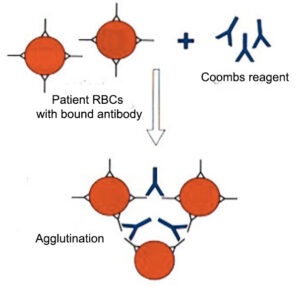In a direct Coombs test, we are looking for the presence of antibodies (IgM or IgG) or opsonic complement components (C3b, C3d, not shown) bound to red blood cells (RBCs) in the patient. We need fresh EDTA-anticoagulated blood for a Coombs test and we first wash the RBCs to remove plasma with any non-adherent antibodies or complement. We then add Coombs reagent, which contains antibodies against species-specific IgG/IgM (i.e.. anti-canine IgG/M, anti-feline IgG/M, anti-equine IgG/M) or C3, using a Coombs reagent specific for the species in question. If there is IgG/M or C3 bound to the RBCs (they do usually do not come of with the washing), the antisera in the Coombs reagent causes agglutination, which can be visualized grossly or microscopically.

